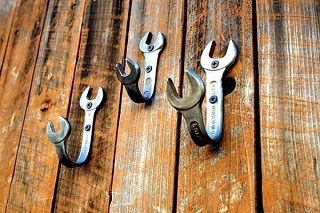From Guest Blogger James Timpton: The Upcycling Effect at Home

Deciding What You Want to Upcycle
The first step is to decide what items you want to upcycle and which ones you are happy to part with. Even if you don’t want to upcycle items yourself there may be plenty of people in need of them, so donate them to charity shops or offer them on one of the freecycle websites.
There will be items which need throwing away, including some which may be deemed hazardous. If you need assistance in this area, to ensure items are disposed of properly, seek the services of a waste management company.
Take Care with Upcycling
There are items you need to take care with when you are upcycling, especially with older paints and varnishes. Particular attention needs to be paid to any furniture which babies or children will come into contact with. Whereas today there are health and safety guidelines in place for any furniture meant for children, these have not always existed, and lead paints and toxic varnishes were often used. This is dangerous for children but also hazardous to any adults stripping down furniture if precautions aren’t taken.
Wooden pallets are also often used for upcycling projects and again be cautious if you are not sure what they were used for, or what they were exposed to, in a previous life.
A Wealth of Projects
That said there is no shortage of safe upcycling projects which you can undertake. You don’t even need to think only in terms of furniture as there are many household items for which another use can be found. Dustbins, glass bottles and even car number plates can be used in new and exciting ways.
Vintage fabric is another area which has seen a huge upsurge in popularity and people will often take a small piece of material, such as their baby’s first dress, and turn it into something else, maybe to form part of a quilt or a soft toy. This preserves the life of the item but also has a great deal of sentimental value to the owner.
Pinterest can be a great source of inspiration and you only need browse some of the many upcycling boards to have your imagination sparked. Many pins will also include free step-by-step tutorials so you can often finish the project by the end of the day.
Upcycling Is Here to Stay
The vintage vibe and the rise in popularity of sites which sell handmade items, such as Etsy, have made upcycling hugely popular of late. However, it now seems less a fad and more a way of life. Upcycling offers so many benefits that even the least craft focused of us are giving it a go.
What then are the advantages of upcycling? We are protecting the environment by preserving natural resources; when we don’t buy new, an item doesn’t require shipping for thousands of miles using precious fuel resources; we are preventing items heading to landfill to pollute the earth; and lastly when we upcycle we know the item hasn’t been made abroad, in a factory where pay is extremely poor and where worker care is low on the list of priorities.
There is also one more piece to the puzzle as when we upcycle we are creating something distinctly our own. We have made something which we can wear, give as a gift or use to adorn our home and in this technological age maybe it is that hands-on quality which makes upcycling so attractive.
